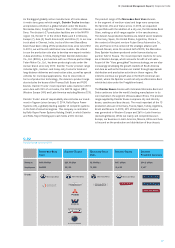Mercedes 2013 Annual Report Download - page 78
Download and view the complete annual report
Please find page 78 of the 2013 Mercedes annual report below. You can navigate through the pages in the report by either clicking on the pages listed below, or by using the keyword search tool below to find specific information within the annual report.
82
Automotive markets
Despite the below-average development of the world economy
in 2013, global demand for cars increased by approximately
5% and thus reached a new record level.
C.06
On the level of regions and countries, the picture is very
disparate, however. The strong expansion of the Chinese market
and market growth in the United States had a particularly
positive impact on worldwide demand. The car market in China
grew by about 18%; the premium segment also continued
its favorable development after a hesitant start to the year and
actually expanded at a rather faster rate than the overall
market. The US market continued its strong recovery and also
made a significant contribution to global growth. Total sales
of 15.5 million cars and light trucks were at their highest level
since 2007.
On the other hand, the overall car market in Western Europe
was once again smaller than in the previous year. However,
demand reached its lowest point in the first half of the year and
then revived slightly. In the full year, the Western European
car market posted a moderate decrease of approximately 2%.
The German market displayed a similar development, but
was below the Western European average with a decrease of 4%.
The market development in the United Kingdom was quite
different with substantial growth of approximately 10%.
In the first half of 2013, the Japanese market was well below
its prior-year level, which had been boosted by state incentives
for car buyers, but compensated for that setback thanks to
the positive development of demand in the second half of the
year. In the major emerging markets with the exception of
China, the growth slowdown had a significant impact on demand
for cars. The car market in Russia was 5% below its prior-year
level while market contraction in India was approximately 8%.
Global demand for medium- and heavy-duty trucks
was noticeably higher than in the prior year. But there were
considerable differences in market developments across
the various regions and countries.
Following a weak first half of the year, the North American
market showed a moderate improvement in the second half,
so that the volume of 2012 was almost equaled in the full year.
In early 2013, the European truck market was below its prior-
year levels by double-digit percentages. But there was a
signi ficant revival also in this region as the year progressed
and the total volume was noticeably higher than in 2012.
One of the main reasons for this acceleration, however, was
that many purchases were brought forward before the intro-
duction of the Euro VI emission standards. The first indications
that this special effect is waning have recently been apparent
in the market.
In Japan, the government’s economic stimulus and the central
bank’s expansive monetary policy had an increasingly positive
impact on the truck business as the year progressed. Sales
in the segment of medium- and heavy-duty trucks exceeded the
prior-year level by approximately 5%. For light-duty trucks,
which include most of the vehicles sold by FUSO, growth was
even stronger at 8%. With expansion of approximately 12%,
the Brazilian market partially recovered from its substantial losses
of the previous year. But this growth was driven more by
catch-up effects and favorable financing possibilities than
by any dynamic development of the Brazilian economy.
Demand for trucks in India decreased dramatically, however.
Below-average economic development also in this market led
to a slump in new registrations of more than 25%. The Russian
truck market also contracted, but at a more moderate rate.
But the world’s biggest market for medium- and heavy-duty trucks
developed positively: Growth of around 17% in China was
ultimately the reason why the global market slightly surpassed
its prior-year volume.
In the region of Western Europe, which is particularly important
for Mercedes-Benz Vans, the market for medium-sized
and large vans was difficult once again in 2013. In the full year,
demand fell by 6%; the markets of southern Europe remained
especially weak. The development of the segment for small vans
was similar. But demand for large vans was strong in Latin
America, where double-digit growth was recorded. The US
market almost equaled its volume of the previous year,
and there was a slight revival of demand in the market segment
we address in China.
Western European bus markets expanded slightly, with
purchases brought forward at the end of the year in advance
of the introduction of Euro VI emission standards. In Turkey,
the bus market profited from the ongoing significant revival
of demand for city buses, although the market weakened
somewhat towards the end of the year due to the political
situation. The Latin American market also revived following
significant contraction in 2012. But demand in Brazil remained
behind expectations in 2013 due to politically related market
uncertainty. Overall, however, the market grew compared with
the previous year.
Unit sales growth rates 2013/2012 in %
Global automotive markets
1 Cars segment includes light trucks
2 Medium- and heavy-duty trucks
15
10
5
0
TotalWestern
Europe NAFTA
region1,2
South
America1,2
Eastern
Europe
Asia
C.06
-10
-5
Passenger cars
Commercial vehicles
Source: German Association of the
Automotive Industry (VDA),
various institutions
























